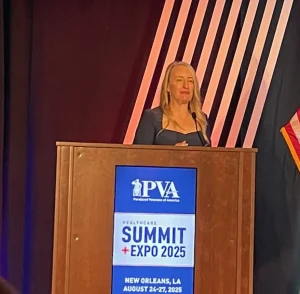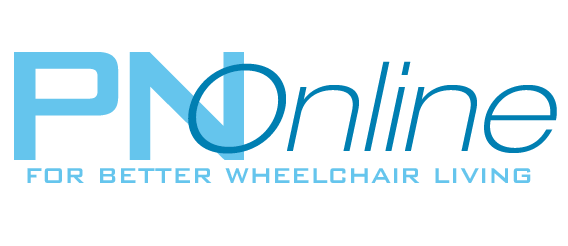Growth of the VA’s ALS System of Care
When a veteran is diagnosed with amyotrophic lateral sclerosis (ALS), he or she begins a journey in which abilities are progressively taken away — and there is no cure. It takes a full team of dedicated health care providers, as well as caregivers, to ensure patients can maintain their quality of life and independence at home.
Studies have shown that ALS affects the veteran population at a greater rate compared to civilians, which prompted the Department of Veterans Affairs (VA) to consider ALS a presumptive service connected disability with a minimum rating of 100% beginning in 2008. And because the VA has seen an increase in veterans seeking ALS care since then, the ALS System of Care has grown organically through departments that were willing to step up and start programs across the VA.

Ileana Howard, MD, professor of rehabilitation medicine at the University of Washington and the medical co-director of ALS Center of Excellence at the VA Puget Sound in Seattle, gave an overview of the ALS System of Care in a keynote speech titled Tenacity and Resilience: What ALS Taught Us Aug. 27 during the Paralyzed Veterans of America Healthcare Summit + Expo at the Hyatt Regency in New Orleans.
“It hasn’t been an easy road, but we are driven every day to continue to work towards improving care for veterans with ALS and their families because of our experience of working with them,” Howard says. “They don’t give up. They show us tenacity, resilience, and that drives us, as well.”
Howard says when she first began her career in 2009, there weren’t many resources for delivery of ALS care. But her first patients and their families gave her the grace to learn along with them. About 15 years later, she was invited to serve on a group for the National Academies of Sciences, Engineering and Medicine, comprising people with lived experience with ALS, pre-symptomatic genetic carriers, ethics experts, physicians across disciplines, experts in technology and in health care disparities and administrators.
Their report, Living with ALS, was released last summer, and Howard says the VA was cited as the model upon which ALS clinical care should be should be built. The VA was cited for being interdisciplinary, proactive and patient-centric.
“What the VA does is incredibly special and unique,” Howard says. “We went from crisis control in 2009 to cutting-edge in the model of care a few years later.”
Howard says she credits this transformation to the fact that ALS care was born into an interdisciplinary rehabilitative model of care and was informed by interaction with veterans with lived experience and their caregivers.
The real changes began in 2014 with a VA ALS Handbook, which encouraged the use of telehealth and cited the SCI model of care as the correct approach to using an interprofessional team as patient-centered for ALS care. In 2021, the handbook advanced to become a VA directive, which provided more accountability and strength behind the requirements for the ALS System of Care.
Today, there are almost 4,000 veterans receiving care for ALS through the VA and there are 101 facilities providing ALS clinical care across the country.
Howard says another element that makes the VA ALS System of Care unique is patient-centered care. She challenged the audience to think about how to include veterans with lived experience in all aspects of VA clinical care, policy decisions, research and education.
“It’s really about respecting those individuals autonomy and self-determination,” she says. “Sometimes veterans make choices about where they want to live and how they want to live, and that might not be our perfect dream of an ideal living situation … it’s using the full team and all the resources that are at our disposal in order to tailor our treatments to the goals and the preferences of the veterans that we serve.”
Howard also emphasized the importance of supporting caregivers of veterans with ALS, many of whom experience significant physical and emotional strain, yet continue to advocate long after their loved ones have passed away to try to help other families like theirs.
When it comes to research, Howard says there is a lot of work to be done, including developing biomarkers for clinical trials or to diagnose individuals earlier and provide effective therapies to slow or halt disease progression. Rehabilitation therapy research is also needed to help maintain or improve veterans’ function. And when those therapies are no longer effective, rehabilitation technologies are needed to help compensate for loss of function and get veterans back in the community. The VA currently has 22 funded projects across the country related to ALS.
“Now, we have partnerships with the FDA [Food and Drug Administration],” Howard says. “In the Seattle VA, there’s the VA Ventures Innovation Institute, where we have regulatory scientists that tour the clinics and talk to clinicians about implementation of complex rehabilitation technologies like robot-assisted therapies, exoskeletons, brain-computer interfaces, so that we’re working together more seamlessly to help the pipeline from discovery to implementation.”
In addition, Howard is involved in the Millennium Cohort Study, a prospective cohort of approximately 260,000 individuals who are enrolled while they’re on active duty in all branches of service. Participants take exposure questionnaires at regular intervals during the study, including when they’re on active duty, and this information is coupled to pre- and post-deployment blood serum samples from the Department of Defense repository. Since enrollment began in 2001, she says about 150 individuals have received an ALS diagnosis.
“So, it’s really important for us to do the work, to try to come up with answers that our veterans and their families deserve to see if there’s any way that we can identify those who may be at risk and mitigate that risk, or try to intervene early to prevent the onset progression of ALS,” Howard says.
Howard says the VA ALS System of Care has made incredible progress in the past 15 years to provide comprehensive, proactive, rehabilitative, focused care to veterans and research that can inform ALS care around the world.
“We are driven by hope, tenacity and their grace, and every day by the feedback that we receive from our veterans that what we do matters so much,” Howard says.
